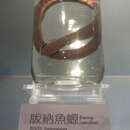en
names in breadcrumbs


The Banna caecilian, Ichthyophis bannanicus, is one of 44 species in the Asian caecilian genus Ichthyophis, (which, as per Nishikawa, Matsui and Yambun 2012 and Nishikawa et al. 2012 includes taxa previously contained in Caudacaecilia).This species is widespread in southeast Asia at altitudes of 100-600 m asl.It occurs commonly in Southern China, northern Vietnam, Laos, northeastern Thailand, and also thought to exist in Myanmar (Zigang et al. 2004; Nishikawa, Matsui and Orlov 2012; Frost 2016). The secret, underground life of Ichthyophis bannanicus and other caecelians means they are not often encountered, and little is known about their relationships and populations. Recent molecular analysis has shown that caecilians from southern Vietnam previously believed to be I. bannanicus are actually a newly described species, Ichthyophis nguyenorum (Nishikawa, Matsui and Orlov, 2012).Genetic barcoding techniques revealed several new Ichthyophis species in 2015, and brought the known number in Indochina (Cambodia, Laos, and Vietnam) from five to eight (Greiger et al. 2015).
Adult Banna caecelians are terrestrial and spend their time digging in moist, loose dirt near small forested streams, eating earthworms.They sometimes come out in vegetated parts along the edges of pools. They measure 32-38 cm in length, and have tiny eyes buried under the skin, and a sensory tentacle near each eye. Banna caecelians are brownish-black above, with a yellow stripe running laterally along each side of its body (Wang 1999). There are two types of coloration pattern in Ichthyophis: striped and not striped. While this characteristic has been shown to have no utility in classifying caecilians, it is useful for identification (Nishikawa, Matsui and Orlov, 2012).
During April to May females dig a shallow hole near water in which they lay about 30 eggs.The larvae are fully aquatic and feed on algae or plankton when small, later eating aquatic invertebrates. They have gills and a short tail with a fin that extends dorsally and around the ventral side of the tail.They use a lateral line on the sides of their head to sense water movement (Wang 1999).
Banna caecilians are found in disturbed habitats and cultivated fields, and the IUCN lists them as adaptable, widespread and “of least concern” for extinction (Zhigang et al. 2004).Wang (1999) however, suggests that populations have declined and are at high risk due to deforestation, pollution, and human activity.
The Koh Tao Island caecilian (Ichthyophis kohtaoensis) is a species of amphibian in the family Ichthyophiidae found in Cambodia, Laos, Myanmar, Thailand, and Vietnam. Also known as the Ichthyophis bannanicus, the Banna caecilian, it is also found in southern China.[3]
Its natural habitats are subtropical or tropical moist lowland forests, subtropical or tropical moist montane forests, rivers, intermittent rivers, swamps, freshwater marshes, intermittent freshwater marshes, plantations, rural gardens, urban areas, heavily degraded former forests, irrigated land, and seasonally flooded agricultural land. It is threatened by habitat loss.[4]
The scientific name refers to Ko Tao Island in the Gulf of Siam, where the type specimen was collected.
The mitotic karyotypes of both the female and male Koh Tao caecilians have 21 pairs of chromosomes, although in a study performed by Nussbaum and Treisman, it was found that there was an inconsistent report of chromosomes. While they all may have the 21 chromosome pairs, there was a study that found they have 18 metacentric, 4 submetacentric, and 20 telocentric chromosomes while another study had found 16 metacentric, 6 submetacentric, and 20 telocentric chromosomes in the caecilians.[5] The conclusion that Ichthyophis genus is a karyologically conserved taxa when it comes to looking at the chromosome numbers.
{{cite journal}}: CS1 maint: multiple names: authors list (link)  Specimen of Ichthyophis bannanicus in National Museum of Natural Science in Taiwan
Specimen of Ichthyophis bannanicus in National Museum of Natural Science in Taiwan The Koh Tao Island caecilian (Ichthyophis kohtaoensis) is a species of amphibian in the family Ichthyophiidae found in Cambodia, Laos, Myanmar, Thailand, and Vietnam. Also known as the Ichthyophis bannanicus, the Banna caecilian, it is also found in southern China.
Its natural habitats are subtropical or tropical moist lowland forests, subtropical or tropical moist montane forests, rivers, intermittent rivers, swamps, freshwater marshes, intermittent freshwater marshes, plantations, rural gardens, urban areas, heavily degraded former forests, irrigated land, and seasonally flooded agricultural land. It is threatened by habitat loss.
The scientific name refers to Ko Tao Island in the Gulf of Siam, where the type specimen was collected.